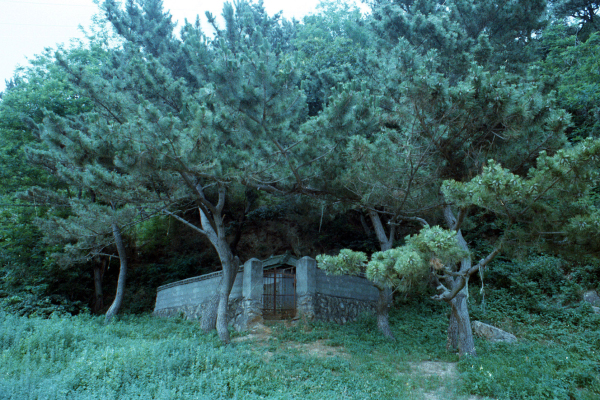한국무속신앙사전
[마을](/topic/마을)굿이나 동제(洞祭)를 지낼 때 풍년ㆍ풍어나 제액(除厄)을 기원하는 마을의 수호신.
definition | [마을](/topic/마을)굿이나 동제(洞祭)를 지낼 때 풍년ㆍ풍어나 제액(除厄)을 기원하는 마을의 수호신. |
|---|---|
mp3Cnt | 0 |
wkorname | 이균옥 |
| 정의 | [마을](/topic/마을)굿이나 동제(洞祭)를 지낼 때 풍년ㆍ풍어나 제액(除厄)을 기원하는 마을의 수호신. | 어원 | 어원적으로는 ‘골(谷)’과 ‘액운을 막다’, ‘[마을](/topic/마을)을 수호하다’라는 뜻을 지닌 ‘막다’가 전성된 명사인 ‘막이’가 결합된 형태이다. ‘맥이’는 ‘막이’의 한글 모음의 ‘l(이)’모음이 역행동화되어 만들어진 것으로 보인다. | 내용 | 골매기’, ‘골맥이 서낭’, ‘골맥이 할배’라고도 하는 골맥이는 주로 경상도의 [마을](/topic/마을)에서 보편적으로 이르는 말이다. 골맥이는 마을굿에서도 신앙의 대상이 되지만 동해안 지방에서는 각 마을의 신으로서 동제의 대상신이 되고 있다. 골맥이신은 마을의 [입향시조](/topic/입향시조)(入鄕始祖)나 창건자로서 마을을 처음으로 가꾸었고, 죽어서는 마을의 수호신이 된 존재이다. 그래서 김씨 할배, 이씨 할매 등으로 성이 붙어 인격신의 형태를 띤다. 여기서 할배나 할매는 조부(祖父)나 조모(祖母)라는 뜻이 아니라 조상(祖上)이라는 의미이다. 골맥이신은 지역마다 조금씩 다르지만 마을 사람들은 대체로 나무, 바위, 당집 등에 신이 존재한다고 믿고 모시고 있다. 골맥이신은 마을에 따라 여러 명이기도 하여 웃당(상당)과 아랫당(하당) 또는 중당이 있는 마을도 있다. 포항 지역에는 웃당이 주로 소나무이다. 이곳에서는 매년 동제나 [별신굿](/topic/별신굿)을 지낼 때 마을 안에 새로운 소나무 [가지](/topic/가지)로 만든 아랫당을 만들기도 한다. 이는 마을신의 생생력을 높이는 행위로 보인다. 별신굿에서는 언제나 굿당을 깨끗하게 하는 ‘부정굿’을 한 다음에 ‘청좌굿’을 진행한다. 골맥이를 모시는 굿은 이 굿거리부터 시작된다. 청좌굿을 무당들은 ‘골맥이 청좌굿’이라고도 부른다. 청좌굿은 마을 당신(堂神)인 골맥이를 굿당에 맞이하는 굿거리이며, 부정굿과 함께 별신굿 전체의 시작 부분에 해당한다. 즉 별신굿 전체를 청신(請神), 오신(娛神), 송신(送神)으로 구분할 때 청신 부분에 해당하는 지극히 양식화된 제의과정이다. 청좌굿의 무가는 주로 여러 서사무가를 축약한 구송과 축원 등 교술(敎述)무가가 뒤섞여서 이루어져 있다. [무악](/topic/무악)(巫樂)이 울리면 주무는 [쾌자](/topic/쾌자)를 걸쳐 입고 [푸너리춤](/topic/푸너리춤)과 무가를 번갈아 가며 연행한다. 무가를 부르는 중간 중간에 대사조로 말을 하면서 호흡을 조절하기도 한다. 양중들은 [바라지](/topic/바라지)를 하며 무녀의 가창에 흥을 돋운다. 무녀는 제물대(祭物臺)에 절하고 술을 올리고는 빠른 [장단](/topic/장단)의 춤을 춘 후 무가를 계속한다. 그리고 무가를 잠시 멈춘 후 대구포를 들고 신칼을 휘두르며 포(鮑)춤을 추다가 제주(祭主)를 앉히고는 대구포로 제주의 등을 누르는 등의 행위를 한다. 이어 [사설](/topic/사설)로 주민들의 정성이 부족함을 나무라지만 곧이어 주민들의 잘못을 용서해 주고 복을 주겠다고 하면서 축원을 한다. 축원을 마치고 나면 제단 위에 있는 술을 한 잔 부어서 제주에게 주고 [음복](/topic/음복) 값을 받는다. 다음에 이어지는 ‘당맞이굿’은 골맥이가 있는 당나무나 당집 등지로 가서 골맥이를 내림대에 내려서 굿당으로 모시고 오는 굿거리이다. 골맥이를 굿당에 모셔 놓은 후부터 굿거리는 본격적으로 시작된다. 별신굿이 벌어지는 굿당에 모셔진 골맥이는 별신굿이 끝나면 다시 원래의 [자리](/topic/자리)로 돌아간다. | 참고문헌 | 한국민속대[사전](/topic/사전) 1 (민족문화사, 1991) 동신당 (김태곤, 민속원, 1999) 한국의 굿 (하효길 외, 도서출판 民俗苑, 2002) 한국민속문화대사전 상 (김용덕, 도서출판 창솔, 2004) | 最早开拓村庄的人死后,被其子孙后代或当地居民信奉为村庄入乡始祖,守护神的人神。 “Golmaegi” 通常被视为是“地方+ 守护”的复合名词。因此,Golmaegi 可谓是照应并保护村庄与村民的存在,免受欲进入村庄的各种灾祸和[不净](/topic/不净)之物侵害。对于 Golmaegi 神的称谓有 Golmaegi 爷爷,Golmaegi 婆婆等表达方式,但女神多于男神。根据迄今为止的调查,主要出现于江原道,庆尚北道,庆尚南道,釜山广域市,蔚山广域市等地。 Golmaegi 根据村庄的不同,所在位置不同。例如,位于村庄后山麓或村庄入口处直立的老巨树,石堆,石人像,村庄祭堂等。以Golmaegi 位于村庄祭堂的情况为例,其神体以牌位,巫神图,石头或以韩纸折成的币帛为象征。在供奉Golmaegi 的大部分村庄中,虽然只供奉爷爷或婆婆中的一位,但不同村庄也有供奉 Golmaegi 夫妇,或同时供奉姓氏不同的三位或四位的情况。正如村庄祭祀仪式多以儒教方式进行一样,“Golmaegi 祭”亦是如此。在进行祭祀仪式时,既有只进行 Golmaegi 祭祀的地方,也有先进行[山神](/topic/山神)祭后再进行 Golmaegi 祭或先进行 Golmaegi 祭后再进行[山神祭](/topic/山神祭)的村庄。 | Golmaegi hace referencia al dios personificado que se basa en el fundador del pueblo, deificado tras su muerte y adorado por sus descendientes o la comunidad local como un dios creador o dios protector. Se cree que el término Golmaegi se originó de la palabra goeul que significa “pueblo” y la de magi que significa “guardián”. Teniendo esto en cuenta, se supone el rol que asume la deidad como un protector de la aldea y sus residentes contra todas las calamidades e impurezas que intentan entrar sigilosamente en la comunidad. Hay los términos alternativos para representar Golmaegi, de ellos, los más representativos son Golmaegihalbae y Golmaegihalmae. Entre muchos nombres que se refieren al Golmaegi, se observan los nombres femeninos más que los masculinos. El culto a Golmaegi se practica generalmente en la provincia de Gangwon, la provincia de Gyeongsangdo, la ciudad de Busan y la de Ulsan. Los lugares donde Golmaegi queda enclaustrado varían según las villas, por ejemplo, un árbol viejo en la entrada de la aldea o colina detrás de la aldea, montículo de piedra, estatua de piedra o santuario del pueblo, en cuyo caso la entidad sagrada toma la forma de una tablilla espiritual, una pintura chamánica, una roca o un papel de morera doblado. En general, la deidad está enclaustrada como un dios o una diosa, pero en algunas aldeas, Golmaegi se adora como una pareja de matrimonio o un grupo de tres o cuadro dioses de diferentes apellidos. El ritual para venerar a Golmaegi, como ritos comunitarios, sigue la tradición confuciana. En algunas aldeas, el ritual se realiza solamente para Golmaegi, mientras que otras llevan a cabo el ritual para Golmaegi como parte del ritual para el dios de la montaña llamado sansinje, antes o después del rito principal. | Golmaegi is a personified god based on the founder of a village, deified after death and worshipped by his descendents or the local community as an originator god or guardian god. The term golmaegi is believed to have come from the words goeul (village) and magi (guardian), to signify the deity’s role as a protector of the village and its residents against all calamities and impurities attempting to enter the community. Alternate versions of the term include Golmaegihalbae (Village Guardian Grandfather) and Golmaegihalmae (Village Guardian Grandmother), and more female deities are observed than males. Golmaegi worship is practiced in Gangwon and South and North Gyeongsang provinces and in Busan and Ulsan areas. Golmaegi is enshrined in a range of venues that vary by village, including old village guardian trees that stand at the village entrance or on the hill behind the village, in stone stacks, stone statues, and the village shrine, in which case the sacred entity takes the form of a spirit tablet, a shamanic painting, a rock or an offering of folded mulberry paper. Generally the deity is enshrined as either a male or female god, but in some villages the deity is worshipped as a married couple or in groups of three or four gods, each with a different family name. Golmaegi rituals, like village rites, are staged in the Confucian tradition, either as an individual rite or as part of mountain god rituals (sansinje), taking place before or after the main rite. |
|---|
| 골맥이 |  64825 골맥이 |
|---|---|
| 골맥이 |  64824 골맥이 |
0 Comments














